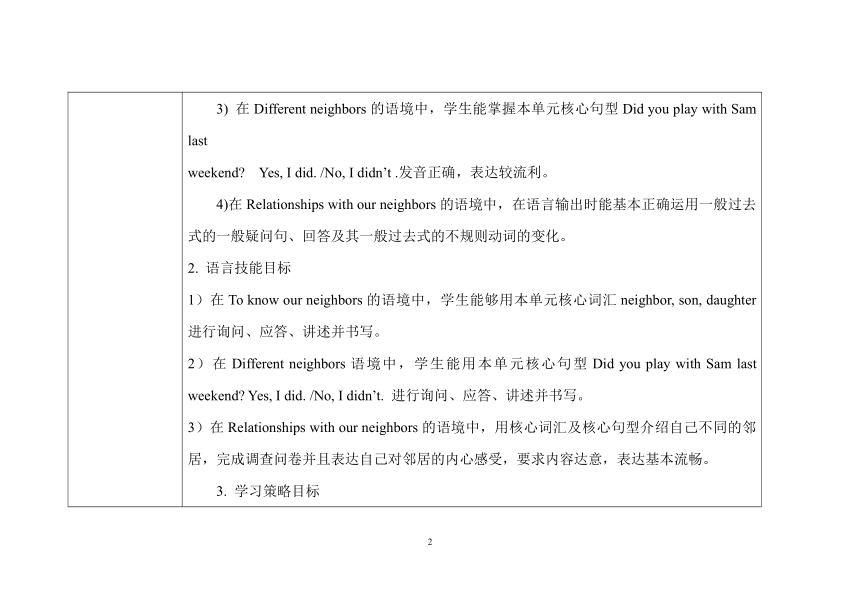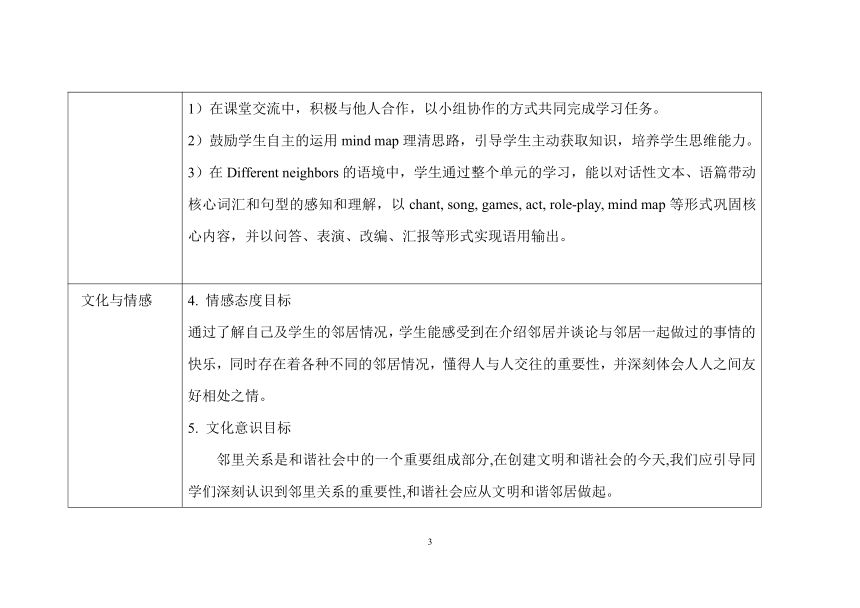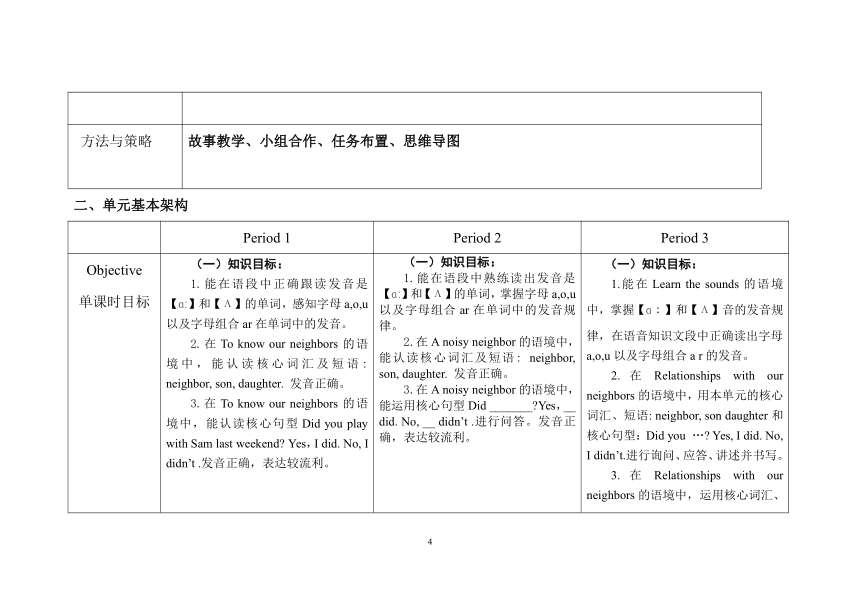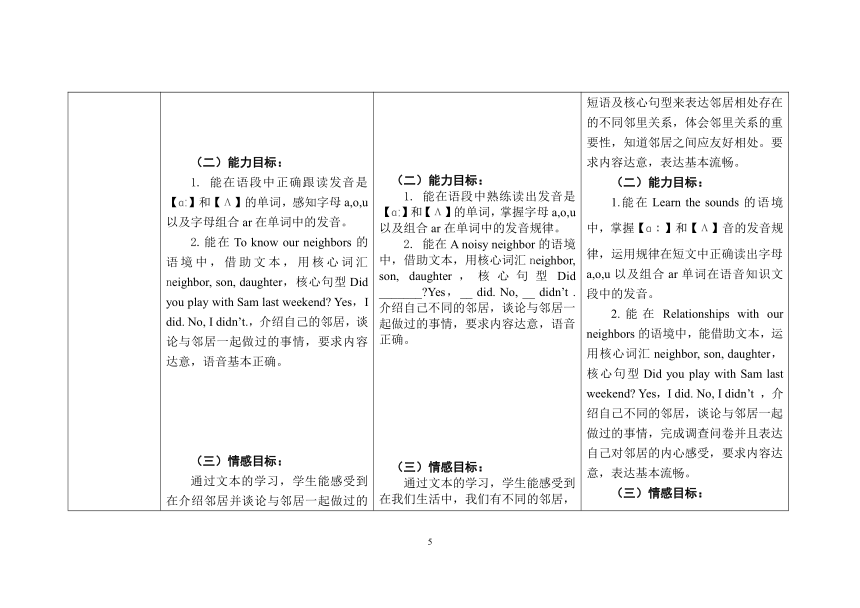Unit 4 Our neighbours 单元整体教学设计(3个课时)
文档属性
| 名称 | Unit 4 Our neighbours 单元整体教学设计(3个课时) |  | |
| 格式 | zip | ||
| 文件大小 | 6.3MB | ||
| 资源类型 | 教案 | ||
| 版本资源 | 牛津深圳版 | ||
| 科目 | 英语 | ||
| 更新时间 | 2018-10-09 15:40:38 | ||
图片预览





文档简介
Unite-based Teaching design
小学英语单元备课共享资源
Title: Book_6B_ Module 2_Unit 4 Our neighbours___
一、单元教学目标 (建议多使用英语课程标准中各级目标的描述语言)
语用任务
能在Our neighbors的语境中,运用核心词汇及句型: neighbor, son, daughter. Did _____? Yes, __ did. / No, ___ didn’t句型,介绍自己不同的邻居,谈论与邻居一起做过的事情,表达自己对邻居的内心感受,正确评价邻居,要求内容达意,表达基本流畅。
知识与技能
1. 语言知识目标
1)掌握【ɑ?】和【Λ】音的发音规律,运用规律在文中正确读出字母a, o, u以及字母组合ar在单词中的发音。
2)在To know our neighbors的语境中,学生能够掌握本单元核心词汇及短语: neighbor, son daughter. 的音、形、义。
3) 在Different neighbors的语境中,学生能掌握本单元核心句型Did you play with Sam last
weekend? Yes, I did. /No, I didn’t .发音正确,表达较流利。
4)在Relationships with our neighbors的语境中,在语言输出时能基本正确运用一般过去式的一般疑问句、回答及其一般过去式的不规则动词的变化。
2. 语言技能目标
1)在To know our neighbors的语境中,学生能够用本单元核心词汇neighbor, son, daughter进行询问、应答、讲述并书写。
2)在Different neighbors语境中,学生能用本单元核心句型Did you play with Sam last weekend? Yes, I did. /No, I didn’t. 进行询问、应答、讲述并书写。
3)在Relationships with our neighbors的语境中,用核心词汇及核心句型介绍自己不同的邻居,完成调查问卷并且表达自己对邻居的内心感受,要求内容达意,表达基本流畅。
3. 学习策略目标
1)在课堂交流中,积极与他人合作,以小组协作的方式共同完成学习任务。
2)鼓励学生自主的运用mind map理清思路,引导学生主动获取知识,培养学生思维能力。
3)在Different neighbors的语境中,学生通过整个单元的学习,能以对话性文本、语篇带动核心词汇和句型的感知和理解,以chant, song, games, act, role-play, mind map等形式巩固核心内容,并以问答、表演、改编、汇报等形式实现语用输出。
文化与情感
4. 情感态度目标
通过了解自己及学生的邻居情况,学生能感受到在介绍邻居并谈论与邻居一起做过的事情的快乐,同时存在着各种不同的邻居情况,懂得人与人交往的重要性,并深刻体会人人之间友好相处之情。
5. 文化意识目标
邻里关系是和谐社会中的一个重要组成部分,在创建文明和谐社会的今天,我们应引导同学们深刻认识到邻里关系的重要性,和谐社会应从文明和谐邻居做起。
方法与策略
故事教学、小组合作、任务布置、思维导图
二、单元基本架构
Period 1
Period 2
Period 3
Objective
单课时目标
(一)知识目标:
1.能在语段中正确跟读发音是【ɑ?】和【Λ】的单词,感知字母a,o,u以及字母组合ar在单词中的发音。
2.在To know our neighbors的语境中,能认读核心词汇及短语: neighbor, son, daughter. 发音正确。
3.在To know our neighbors的语境中,能认读核心句型Did you play with Sam last weekend? Yes,I did. No, I didn’t .发音正确,表达较流利。
(二)能力目标:
1. 能在语段中正确跟读发音是【ɑ?】和【Λ】的单词,感知字母a,o,u以及字母组合ar在单词中的发音。
2.能在To know our neighbors的语境中,借助文本,用核心词汇neighbor, son, daughter,核心句型Did you play with Sam last weekend? Yes,I did. No, I didn’t.,介绍自己的邻居,谈论与邻居一起做过的事情,要求内容达意,语音基本正确。
(三)情感目标:
通过文本的学习,学生能感受到在介绍邻居并谈论与邻居一起做过的事情的快乐,体会到人与人交往的重要性,并深刻体会人人之间友好相处之情。
(一)知识目标:
1.能在语段中熟练读出发音是【ɑ?】和【Λ】的单词,掌握字母a,o,u以及字母组合ar在单词中的发音规律。
2.在A noisy neighbor的语境中,能认读核心词汇及短语: neighbor, son, daughter. 发音正确。
3.在A noisy neighbor的语境中,能运用核心句型Did _______?Yes,__ did. No, __ didn’t .进行问答。发音正确,表达较流利。
(二)能力目标:
1. 能在语段中熟练读出发音是【ɑ?】和【Λ】的单词,掌握字母a,o,u以及组合ar在单词中的发音规律。
2. 能在A noisy neighbor的语境中,借助文本,用核心词汇neighbor, son, daughter,核心句型Did _______?Yes,__ did. No, __ didn’t .介绍自己不同的邻居,谈论与邻居一起做过的事情,要求内容达意,语音正确。
(三)情感目标:
通过文本的学习,学生能感受到在我们生活中,我们有不同的邻居,鼓励学生主动了解邻居,尊重差异。
21(一)知识目标:
1.能在Learn the sounds的语境中,掌握【ɑ?】和【Λ】音的发音规律,在语音知识文段中正确读出字母a,o,u以及字母组合a r的发音。
2.在Relationships with our neighbors的语境中,用本单元的核心词汇、短语: neighbor, son daughter和核心句型:Did you …? Yes, I did. No, I didn’t.进行询问、应答、讲述并书写。
3.在Relationships with our neighbors的语境中,运用核心词汇、短语及核心句型来表达邻居相处存在的不同邻里关系,体会邻里关系的重要性,知道邻居之间应友好相处。要求内容达意,表达基本流畅。
(二)能力目标:
1.能在Learn the sounds的语境中,掌握【ɑ?】和【Λ】音的发音规律,运用规律在短文中正确读出字母a,o,u以及组合ar单词在语音知识文段中的发音。
2.能在Relationships with our neighbors的语境中,能借助文本,运用核心词汇neighbor, son, daughter,核心句型Did you play with Sam last weekend? Yes,I did. No, I didn’t ,介绍自己不同的邻居,谈论与邻居一起做过的事情,完成调查问卷并且表达自己对邻居的内心感受,要求内容达意,表达基本流畅。
(三)情感目标:
通过谈论不同的邻居以及调查问卷,学生能感受到邻居相处存在着不同的邻里关系,体会到人与人交往的重要性以及人与人之间友好相处之情。
Topic
单课时话题
Period 1: To know our neighbours
Period 2:Our different neighbours
Period 3:Relationships with our neighbors
Content
单课时教学文本
Blackboard design
板书设计
三、单课教学设计
Period 1
Procedures
Contents
Methods
Purpose
Pre-task
preparation
【Sing a song】
播放歌曲,与学生一起欢快歌唱。
【Enjoy the song】
播放关于朋友之间的图片,伴随音乐,感受nice friends.
播放音乐,PPT插入歌词。
伴随音乐播放关于人与人之间关系的图片。感受nice friends.
活跃课堂气氛,激发学生学习的兴趣,铺垫情景。
2. 通过师生共同唱起朋友之歌体会人与人之间的关系。
While-task procedure
Post-task procedure
Sum up
1. 【Learn the sounds】
1.1 Ask and answer
T: Look!
What can we see?
What are they doing?
Where do mum and son go? What is coming?
1.2 Listen and follow
感知字母a,o,e以及字母组合ar的发音.
1.3 Learn the words
class past ask bath
arm park sharp large
us up club duck
other son love colour
1.4 Find the rules
和学生一起观察、思考并发现发音规则。
T: “A” comes to the sound of [ɑ?].
“Ar” comes to the sound of [ɑ?].
“O” comes to the sound of [Λ].
“U” comes to the sound of [Λ].
2.【To know our neighbours】
2.1 Free talk and lead in .
T: Look, this is Peter. Where does he live?
T:Look, they are Peter’s neighbours. 引入教授新单词neighbours.
T: Peter has so many neighbours. Do you know your neighbours? Who are they? T: What did you do with your neighbours?
T: You can do a lot of things with your neighbours. How nice!
2.2 Listen and answer
T: Peter is in the classroom with his teacher and his classmates now.
T: What are they talking about? Let’s watch the video.
3.【Peter’s neighbours】
3.1 Listen and answer根据回答完成板书。
T: Who is Peter’s neighbour? Where are they from? What do they do? First, let’s listen to the first part of the passage.
3.2听音教授新单词 daughterson.
3.3 Free talk
T: This is about Peter’s neighbours. Let’s know our neighbours.
3.4 Listen and answer
T: What did Peter do with his neighbour?
T: Did Peter see Mr. Green and Mrs. Green?
T: Did Peter read books with Mike and Nancy?
T:Did Peter play with Mike and Nancy?
3.5 Free talk
T:What did you do with your neighbours last weekend/ yesterday?
T: Did you…?
Talk with your partners.
3.6 Follow the recording
3.7 Role play T&Ss
T: Who are your neighbours, Peter ?Do you know them?
T: Now, I am Mrs. Guo, you are Peter.
4.【Alice’s neighbours】
4.1 Read books with the language frame.
T: Who is Alice’s neighbour? What did they do last weekend?
4.2 Group answers
Teacher shows the pictures on PPT with the language frame.
4.3 Groups role play
T: Now, Group1 and 2, you are Alice, Group3 and 4, you are Mrs. Guo.
Then exchange.
4.4 Free talk
T: What do you often do with your neighbour? Let’s say by yourself..
1. Retell the whole dialogue
Point to the board design and say.
T: Peter and Alice have neighbours.___are Peter’s neighbours.
They’re from…
Mr. Green is a…
Mrs. Green is a…
Peter played with Mike and Nancy last weekend.
…are Alice’s neighbours.
Alice played chess with Sam.
2. Talk about our neighbours
T: We all have neighbours. How about your neighbours? Let’s talk.
T: We all have neighbours. To know your neighbours and do something with your neighbours.
PPT
听录音
板书
看、听、说
PPT
板书neighbours
PPT
播放视频
PPT
PPT
板书WhoWhere
Job的相关内容
板书完整的课题To know our neighbours。
PPT出示语言框架
听录音进行问答
板书What部分的内容以及核心句型。
PPT
听录音
PPT
PPT
PPT出示语言框架
PPT
PPT
板书
1.1通过听音和文字引出语音知识文段,并通过简单问题的提问理解语音文段的大意,初步感知发音。
1.2听音跟读感知字母a,o,e以及字母组合ar的发音。
1.3利用语音知识文段的情境,初步感知并学习核心单词。
1.4.老师带着学生一起观察、思考并发现发音规则。
2.1通过问答形式引起同学们的注意,提出问题积极思考,初步感知本课话题。
2.2视听输入,引导学生在语境中感知文本的整体性,提取文本信息。
3.1通过听音呈现文本,帮助学生学习目标单词和句型,引导学生初步感知 Peter’s neighbours。
3.2学习核心单词。
3.3通过交谈,让学生在真实的情境中谈论自己邻居最基本的情况。
3.4通过问答更深入感知Peter和Peter’s neighbours一起做过的事情。
3.5 通过PPT展示学习过的一些动词短语进行Free talk。
3.5通过生生之间真实的互动用过去式问句以及陈述句谈论与邻居一起做过的事情。
3.6-3.7整体跟读文本后,老师和同学们扮演Mrs. Guo 和Peter一起来完成一段小语段。
4.1听音输入,引导学生在语境中感知文本,通过给出的语言框架,增加难度,让学生提取文本信息。
4.2通过小组回答,出示Alice’s neighbours.
4.3通过小组进行角色对话,整体学习语段。
4.4通过学习Peter’s and Alice’s neighbours, 谈论学生自己和邻居经常在一起做的事情,进而感受邻里之间的和睦友好相处之情。
1.整体回顾文
本,复述文本。
2. 完成介绍自己的邻居并表达自己与邻居经常和曾经一起做过的事情,体会邻里之间的友好相处的关系。
Assignment
1. Read the dialogue 3 times. (Compulsory homework)
2. Talk about your Spring Festival plan. (Optional homework)
Period 2
Procedures
Contents
Methods
Purpose
Pre-lesson
1.Sing the song
2.Learn the sounds
3.发音规则
1.【Sing a song】 播放歌曲,与学生一起欢快歌唱。
2. 【Learn the sounds.】
2.1 Read the sentences
出示语音图文片段,让学生朗读复习语音句子。
T:Read the sentences again
2.2.Pick out the words
让学生挑出含【ɑ?】和【Λ】发音的单词。
2.3 Find the rules.
让学生观察、思考发音规则。
2.4 Learn more words
拓展其他发音是【ɑ?】和【Λ】的单词。先由学生头脑风暴找,然后老师给出一些进行训练。
3. 【Check the homework】
让学生上台展示“Think and Write”部分作业(请2-3位同学)
4. 【Ask and answer】
台下同学用Did you…with…?Yes, I did. /No, I didn’t.询问上台介绍的同学与其邻居之间的相关信息。先由老师示范问,然后请其他同学问。
1.活跃课堂气氛,激发学生学习的兴趣,铺垫情境。
2.1 通过朗读,及时复习。
2.2.通过反复刺激,进一步感知发音规律。
2.3 通过学生自己的观察思考,加深印象,培养学生归纳总结的能力。
2.4 通过对其他单词的拓展,巩固发音规律。
3. 检查作业
检查学生对新知识的掌握情况,同时让学生体会分享的快乐。
4. 通过谈论同学们的邻居,师生、生生之间的问答,复习句型Did you…with…?Yes, I did. /No, I didn’t.
While-task procedure
1.1Ask and answer.
S1: In the holes.
S2: Under the tree.
S3: The owl.
S4: No, it didn’t. Under the tree.
1.2课文完整视频。
1.3 发散思维,讨论总结the owl是一个怎么样的邻居,和rabbits的邻里关系是如何的。
S1: The owl was noisy.
S2: The owl was bad.
S3: The owl was not good...
S2: No, he wasn’t. He was not a good neighbour.
S3: No, they didn’t. They were angry.
1.4 Read the story
1.5 Retell the story.
根据板书复述这一部分的故事
1.6 Brainstorm
大胆假设,如果你是兔子,面对这样的邻居,你会怎么做?小组讨论。
S1:Argue with it.
S2: Keep silent.
S3: Call 110.
S4: Move.
S5: Wear an earphone
Ss: ...
2. 【Move to the hole】
2.1 Watch and answer
带着问题再次观看整个的故事视频。
S1: No, they didn’t.
S2: They had an idea:”dig a hole and sleep in it.”
S3: They felt quiet.
S4: They felt happy.
S5: They had a good sleep.
2.2 Present the ending of the story
T&Ss:In the end, the rabbits lived in the holes.
2.3 Retell the second part of the story
学生看着板书复述第二部分的故事。
1.1 Ask and answer
采用倒叙的方法,通过问答先引出兔子现在的住所是in the hole, 然后再问一开始是住在哪。通过这样的对比,让学生对其中的原因产生兴趣。
1.2 Listen and answer
让学生带着问题整体看视频。
1.3 Sum up
让学生发散思维,讨论总结the owl是一个怎么样的邻居,和rabbits的邻里关系是如何的。
1.4 Read the story
1.5 Retell the story.
让学生根据板书复述这一部分的故事。
1.6 Brainstorm
让学生大胆假设,如果你是兔子,面对这样的邻居,你会怎么做?小组讨论。
2.1 Watch and answer
让学生带着问题再次观看整个的故事视频。
2.2 Present the ending of the story
2.3 Retell the second part of the story
让学生看着板书复述第二部分的故事。
1.1 采用倒叙的方法,通过问答先引出兔子现在的住所是in the hole, 通过这样的对比,让学生对其中的原因产生兴趣,为接下来的原因探索打下基础。
1.2通过问答形式引起同学们的注意,提出问题积极思考,整体感知故事。并在问答过程中不断巩固本课的核心句型。
1.3学生通过讨论猫头鹰是一个怎么样的邻居,以及兔子的反应,让学生以兔子的角度感同身受,深刻体会这个邻居与其他邻居的不同。
1.4. 通过跟读和复述,加深故事理解。
1.5 通过复述板书,进一步加深理解,加强对故事的流畅阅读。
1.6 大胆讨论,培养学生想象力和主动参与性。在问答过程中通过教师的帮助拓展学生词汇,提高表达能力。同时为故事下半部分做铺垫和过渡。
2.1 带着问题再次整体理解故事,边看边寻找答案。
2.2 揭晓答案,回应最开始的问题。
2.3 通过复述板书,进一步加深理解,加强对故事的流畅阅读。
Post-task activity
1. Groups role play
分组进行角色扮演故事。
2. Talk about neighbors.
口头谈论自己不一样的邻居:先看老师示范谈论他自己的,然后根据模板谈论自己的。
S1: Our neighbours are different.
____ is my neighbor, too.
He is____.
He is a/ an_____.
I never/ sometimes/
often/seldom ______.
S2...
3. Finish the worksheet
Write about our different
neighbours with the language frame.
Groups role play
T: Now, Group1, 2 and 3, you are rabbits, Group4, you are narrator.
Then exchange.
Talk about students’ neighbours.
口头谈论自己不一样的邻居:教师先示范谈论自己的,然后引导学生根据模板谈论自己的。
T: The rabbits’ neighbour was noisy. It was different. What about your neighbours?
T:Our neighbours are different.
Mr. Song is my neighbour, too. He is twenty-eight. He is a teacher, too. I never go to school with him. I sometimes play basketball with him.
T: What about your neighbours? Talk about it.
3. Tips of Homework“Finish the worksheet”
T: We all have neighbours. But some are different. Now, let’s write your different neighbours.
1.通过小组进行角色对话,整体学习语段。
2. 发散性问题,锻炼学生思维,并适当拓展词汇。同时为家庭作业“Finish the worksheet” 打下基础。
3.在上一课时介绍自己的邻居的基础上,添加介绍一位不一样的邻居。体会我们的邻居们是有不同性格、类型的。
Assignment
作业布置
T: We all have neighbours. But neighbours are different. Different neighbours can make our life more colourful.
1.熟读Learn the sound部份。
2.熟读故事。
3.完成Worksheet的Period2书写部分。
Period 3
Procedures
Contents
Methods
Purpose
Pre-lesson
Sing a song
2. Learn the sounds
通过有字母a,o,u以及组合ar字母组合的新词,以方法指导和抢答的方式复习旧的单词,鼓励学生尝试拼读新单词后,带领学生读出语音知识文段。
1.跟随视频,与老师一起欢快地歌唱
2.展示手势和PPT示范字母发音
1.活跃课堂气氛,激发学生学习的兴趣,铺垫情境。
2.在语境中,复习旧单词并运用发音规律,正确拼读含有字母a,o,u以及组合ar字母组合的新词。通过朗读语音知识文段,将语境和语义相结合,进一步强化字母a,o,u以及组合ar字母在语音知识文段中的发音。
Pre-task preparation
Revise the rules
Finish the exercises
Let’s check
Check the homework
3.Read and think.
4.Think and finish the exercises. Listen and circle.
5.Show the homework
3.复习语音知识并运用巩固
While-task procedure
3.【Lead in】
通过复习自然引入新课。
3.1 引导学生模仿和表演对话,学会提问和回答。
T: Look at the picture, Let’s imitate the dialogue and act out the dialogue.
T: Try to get the meaning at the same time. After that, let’s answer the question.
3.2通过对话让孩子们进行头脑风暴来对Peter和Alice的邻居进行评价。
T: Do you know Peter’s neighbour’s name?
T: Do you know their jobs?
T: Did you play with them together?
T: What do you think of your neighbours?
T: Why?
3.3 播放A noisy neighbour 的故事视频。
T: Was the owl a good neighbour?
引导孩子在视觉冲击后进行头脑风暴。
4.【New lesson】
4.1 Do a quiz.
T: How about your neighbours?
T: How well do you know about your neighbours? Let’s finish the quiz.
4.2根据得分,评价How well do you know your neighbours ?
4.3收集整理
5.【Practice】
5.1 Think and write
T: We have neighbours, choose one and write down about your neighbour.
5.2 Show the kids’ works
5.3 Let the Kids talk about their neighbours.
6.【Learn the picture book】
6.1 了解故事发生的背景和主人公的邻居有哪几个。
T: Look, Tommy’s family just moved into a new apartment. How many neighbours does he have? Who are they? Let’s know more and more neighbours. Please watch the video.
6.2 自主阅读,探究答案。
学生读第1-2幅画,找出Tommy的邻居的相关信息。
6.2.1 Ask and answer.
T: Did he meet the old lady this morning?
T: Did she give some delicious cookies to Tommy?
T: What do you think of the old lady?
6.2.2 Think and do
学生听第3幅画的录音,完成Task 1。
T: This time, let’s think and do. First, listen to the tape and finish the exercise.
T: Check the task.
6.3 小组合作,完成Task 2。
6.3.1教师呈现第4幅图,引导4人一个小组通过阅读的方式获取关键信息,然后通过合作讨论共同完成Task 2.
T: Now Let’s look at picture 4. Read the text carefully with your group members. Discuss it and finish the picture together.
3.1观看课本Read a story栏目,找出故事的顺序,并进行抢答
3.2.让学生完成Read a story的后续练习,然后全班核对答案。
3.3
PPT展示
学生自己完成调查表,然后小组交流谈论,小组间进行对比。
板书
PPT展示
头脑风暴后回答
PPT展示
PPT展示
学生阅读图画获取信息,然后回答问题。
Answer the questions
PPT展示
小组合作
在四人小组中,大家共同讨论,大家一起记录获取到的信息,并指定一人将最后答案写在横线上。
3.1复习第一课时及第二课时所学的人物、核心词汇与句型。以播放视频、PPT、头脑风暴,增强视觉冲击,提高兴趣,突破重难点,体会情感。
4.通过完成调查问卷表,学习动词词组:say hello to them, talk to them, help them, have fun together…体会邻居间的关系。
5. 思维碰撞,手脑并用。根据真实的生活存在的邻居,运用本课核心词汇及核心句型来体验自己的真实体会。
6. 通过视听呈现绘本,引导学生认识和了解更多的邻居,体会各种各样的不同邻里关系,认识到人与人之间相处的重要性。
Post-task activity
【Sum up】
1. T: Retell the whole dialogue with the help on the board.
2. T: Point to the board design and say.
T: Peter and Alice have neighbours.
What did they do?
T: The rabbits have neighbour.
What about their neighbour?
2.1. Talk about Tommy’s neighbours
T: Tommy has neighbours. How about his neighbours? Let’s talk.
T: How about the young couple? Let’s talk.
T: The neighbours are kind and helpful, How about the other neighbours. Was she good to Tommy?
3.Everybody did a good job. Now let’s finish the worksheet.
【Sum up】
1. Retell the whole dialogue with the help on the board.
2. Think and answer the questions.
.
2.1整理本课学习内容,将所学的整理归纳,形成完整的文本。
1.通过问答及交谈,描述邻居,学生能够真实体会各种各样的邻居,了解他们的工作,爱好等。在语境中进行询问、应答、和讲述。要求内容达意,表达基本流畅。
2.1.描述Tommy的邻居并表达他与邻居经常和曾经一起做过的事情,体会邻里之间的友好相处的关系。
3. 语言输出。学生在听、说、读本课核心词汇及核心句型的基础上,能够写出真实的语境并运用本课句型进行书写,写作。
Assignment
1. Talk about your more neighbours.
2. Finish the worksheet.
3.Write a composition
四、阅读素养评价
(A)
Six friends
There are six friends in the Green Woods.They are happy. The bird is the singer. She sings songs in the tree. The dog is an artist. He draws pictures on the ground. Look at the monkey. He is so funny. He makes the animals happy. What does he do? He’s an actor.(演员) The street is so clean. Who is the cleaner? The bear is sweeping the fallen leaves. The parrot is a reporter. She reports news everyday. What does the black cat do? Look! He is patrolling (巡逻) with his handgun(手枪) by motorcycle(摩托车). He’s a policeman.
根据短文内容,判断对(T)错(F)。
( ) 1. The bird is a singer.
( ) 2. The monkey is an actress.
( ) 3. The parrot is a policeman.
( ) 4.The dog draws pictures on the ground. He’s an artist.
( ) 5.The bear is cleaning the fallen leaves. He’s a cleaner
(B)
Mr. going-to-do
The Browns are the Smiths’ neighbours. Mr. Brown’s name is John. But when his neighbours talk about him, they call him “Mr. going-to-do”. Do you know why? Mr. Brown always says he is going to do something, but he never does it.
Every Saturday Mr. Brown goes to the Smiths’ back door and talks to Mr. Smith. He says, “I am going to clean my house today.” or “I am going to wash my car tomorrow. “ or “The trees in front of my house are too big. I’m going to cut them down next week.”
Mr. Smith usually says, “Are you, John?” He knows his neighbours is not going to clean his house, or wash his car, or cut down any trees. Then he says, “Well, excuse me, John, I’m going to do some work in the house.” And so he does.
Mr. and Mrs. Smith often says to their only child Dick, “Are you going to do something? Then do it! Don’t be another Mr. going-to-do!”
根据短文内容,选择正确的答案。
( )1.Mr. Brown’s house is ___Mr. Smith’s.
A.far B. near C. with
( )2.John talks a lot but does________.
A. something. B. anything C. nothing
( )3. Mr. Smith _____
wants his son to be a man like John B. is pleased to talk with John
C. becomes tired of John’s empty talks
( )4. “Mr. going -to-do”_____ .
A.usually needs help when he is going to do something
B. always promises to do something, but never does
C. talks a lot and does a lot
( )5.You are a person like _________.
Mr. Smith B. Mr. John C .Dick
小学英语单元备课共享资源
Title: Book_6B_ Module 2_Unit 4 Our neighbours___
一、单元教学目标 (建议多使用英语课程标准中各级目标的描述语言)
语用任务
能在Our neighbors的语境中,运用核心词汇及句型: neighbor, son, daughter. Did _____? Yes, __ did. / No, ___ didn’t句型,介绍自己不同的邻居,谈论与邻居一起做过的事情,表达自己对邻居的内心感受,正确评价邻居,要求内容达意,表达基本流畅。
知识与技能
1. 语言知识目标
1)掌握【ɑ?】和【Λ】音的发音规律,运用规律在文中正确读出字母a, o, u以及字母组合ar在单词中的发音。
2)在To know our neighbors的语境中,学生能够掌握本单元核心词汇及短语: neighbor, son daughter. 的音、形、义。
3) 在Different neighbors的语境中,学生能掌握本单元核心句型Did you play with Sam last
weekend? Yes, I did. /No, I didn’t .发音正确,表达较流利。
4)在Relationships with our neighbors的语境中,在语言输出时能基本正确运用一般过去式的一般疑问句、回答及其一般过去式的不规则动词的变化。
2. 语言技能目标
1)在To know our neighbors的语境中,学生能够用本单元核心词汇neighbor, son, daughter进行询问、应答、讲述并书写。
2)在Different neighbors语境中,学生能用本单元核心句型Did you play with Sam last weekend? Yes, I did. /No, I didn’t. 进行询问、应答、讲述并书写。
3)在Relationships with our neighbors的语境中,用核心词汇及核心句型介绍自己不同的邻居,完成调查问卷并且表达自己对邻居的内心感受,要求内容达意,表达基本流畅。
3. 学习策略目标
1)在课堂交流中,积极与他人合作,以小组协作的方式共同完成学习任务。
2)鼓励学生自主的运用mind map理清思路,引导学生主动获取知识,培养学生思维能力。
3)在Different neighbors的语境中,学生通过整个单元的学习,能以对话性文本、语篇带动核心词汇和句型的感知和理解,以chant, song, games, act, role-play, mind map等形式巩固核心内容,并以问答、表演、改编、汇报等形式实现语用输出。
文化与情感
4. 情感态度目标
通过了解自己及学生的邻居情况,学生能感受到在介绍邻居并谈论与邻居一起做过的事情的快乐,同时存在着各种不同的邻居情况,懂得人与人交往的重要性,并深刻体会人人之间友好相处之情。
5. 文化意识目标
邻里关系是和谐社会中的一个重要组成部分,在创建文明和谐社会的今天,我们应引导同学们深刻认识到邻里关系的重要性,和谐社会应从文明和谐邻居做起。
方法与策略
故事教学、小组合作、任务布置、思维导图
二、单元基本架构
Period 1
Period 2
Period 3
Objective
单课时目标
(一)知识目标:
1.能在语段中正确跟读发音是【ɑ?】和【Λ】的单词,感知字母a,o,u以及字母组合ar在单词中的发音。
2.在To know our neighbors的语境中,能认读核心词汇及短语: neighbor, son, daughter. 发音正确。
3.在To know our neighbors的语境中,能认读核心句型Did you play with Sam last weekend? Yes,I did. No, I didn’t .发音正确,表达较流利。
(二)能力目标:
1. 能在语段中正确跟读发音是【ɑ?】和【Λ】的单词,感知字母a,o,u以及字母组合ar在单词中的发音。
2.能在To know our neighbors的语境中,借助文本,用核心词汇neighbor, son, daughter,核心句型Did you play with Sam last weekend? Yes,I did. No, I didn’t.,介绍自己的邻居,谈论与邻居一起做过的事情,要求内容达意,语音基本正确。
(三)情感目标:
通过文本的学习,学生能感受到在介绍邻居并谈论与邻居一起做过的事情的快乐,体会到人与人交往的重要性,并深刻体会人人之间友好相处之情。
(一)知识目标:
1.能在语段中熟练读出发音是【ɑ?】和【Λ】的单词,掌握字母a,o,u以及字母组合ar在单词中的发音规律。
2.在A noisy neighbor的语境中,能认读核心词汇及短语: neighbor, son, daughter. 发音正确。
3.在A noisy neighbor的语境中,能运用核心句型Did _______?Yes,__ did. No, __ didn’t .进行问答。发音正确,表达较流利。
(二)能力目标:
1. 能在语段中熟练读出发音是【ɑ?】和【Λ】的单词,掌握字母a,o,u以及组合ar在单词中的发音规律。
2. 能在A noisy neighbor的语境中,借助文本,用核心词汇neighbor, son, daughter,核心句型Did _______?Yes,__ did. No, __ didn’t .介绍自己不同的邻居,谈论与邻居一起做过的事情,要求内容达意,语音正确。
(三)情感目标:
通过文本的学习,学生能感受到在我们生活中,我们有不同的邻居,鼓励学生主动了解邻居,尊重差异。
21(一)知识目标:
1.能在Learn the sounds的语境中,掌握【ɑ?】和【Λ】音的发音规律,在语音知识文段中正确读出字母a,o,u以及字母组合a r的发音。
2.在Relationships with our neighbors的语境中,用本单元的核心词汇、短语: neighbor, son daughter和核心句型:Did you …? Yes, I did. No, I didn’t.进行询问、应答、讲述并书写。
3.在Relationships with our neighbors的语境中,运用核心词汇、短语及核心句型来表达邻居相处存在的不同邻里关系,体会邻里关系的重要性,知道邻居之间应友好相处。要求内容达意,表达基本流畅。
(二)能力目标:
1.能在Learn the sounds的语境中,掌握【ɑ?】和【Λ】音的发音规律,运用规律在短文中正确读出字母a,o,u以及组合ar单词在语音知识文段中的发音。
2.能在Relationships with our neighbors的语境中,能借助文本,运用核心词汇neighbor, son, daughter,核心句型Did you play with Sam last weekend? Yes,I did. No, I didn’t ,介绍自己不同的邻居,谈论与邻居一起做过的事情,完成调查问卷并且表达自己对邻居的内心感受,要求内容达意,表达基本流畅。
(三)情感目标:
通过谈论不同的邻居以及调查问卷,学生能感受到邻居相处存在着不同的邻里关系,体会到人与人交往的重要性以及人与人之间友好相处之情。
Topic
单课时话题
Period 1: To know our neighbours
Period 2:Our different neighbours
Period 3:Relationships with our neighbors
Content
单课时教学文本
Blackboard design
板书设计
三、单课教学设计
Period 1
Procedures
Contents
Methods
Purpose
Pre-task
preparation
【Sing a song】
播放歌曲,与学生一起欢快歌唱。
【Enjoy the song】
播放关于朋友之间的图片,伴随音乐,感受nice friends.
播放音乐,PPT插入歌词。
伴随音乐播放关于人与人之间关系的图片。感受nice friends.
活跃课堂气氛,激发学生学习的兴趣,铺垫情景。
2. 通过师生共同唱起朋友之歌体会人与人之间的关系。
While-task procedure
Post-task procedure
Sum up
1. 【Learn the sounds】
1.1 Ask and answer
T: Look!
What can we see?
What are they doing?
Where do mum and son go? What is coming?
1.2 Listen and follow
感知字母a,o,e以及字母组合ar的发音.
1.3 Learn the words
class past ask bath
arm park sharp large
us up club duck
other son love colour
1.4 Find the rules
和学生一起观察、思考并发现发音规则。
T: “A” comes to the sound of [ɑ?].
“Ar” comes to the sound of [ɑ?].
“O” comes to the sound of [Λ].
“U” comes to the sound of [Λ].
2.【To know our neighbours】
2.1 Free talk and lead in .
T: Look, this is Peter. Where does he live?
T:Look, they are Peter’s neighbours. 引入教授新单词neighbours.
T: Peter has so many neighbours. Do you know your neighbours? Who are they? T: What did you do with your neighbours?
T: You can do a lot of things with your neighbours. How nice!
2.2 Listen and answer
T: Peter is in the classroom with his teacher and his classmates now.
T: What are they talking about? Let’s watch the video.
3.【Peter’s neighbours】
3.1 Listen and answer根据回答完成板书。
T: Who is Peter’s neighbour? Where are they from? What do they do? First, let’s listen to the first part of the passage.
3.2听音教授新单词 daughterson.
3.3 Free talk
T: This is about Peter’s neighbours. Let’s know our neighbours.
3.4 Listen and answer
T: What did Peter do with his neighbour?
T: Did Peter see Mr. Green and Mrs. Green?
T: Did Peter read books with Mike and Nancy?
T:Did Peter play with Mike and Nancy?
3.5 Free talk
T:What did you do with your neighbours last weekend/ yesterday?
T: Did you…?
Talk with your partners.
3.6 Follow the recording
3.7 Role play T&Ss
T: Who are your neighbours, Peter ?Do you know them?
T: Now, I am Mrs. Guo, you are Peter.
4.【Alice’s neighbours】
4.1 Read books with the language frame.
T: Who is Alice’s neighbour? What did they do last weekend?
4.2 Group answers
Teacher shows the pictures on PPT with the language frame.
4.3 Groups role play
T: Now, Group1 and 2, you are Alice, Group3 and 4, you are Mrs. Guo.
Then exchange.
4.4 Free talk
T: What do you often do with your neighbour? Let’s say by yourself..
1. Retell the whole dialogue
Point to the board design and say.
T: Peter and Alice have neighbours.___are Peter’s neighbours.
They’re from…
Mr. Green is a…
Mrs. Green is a…
Peter played with Mike and Nancy last weekend.
…are Alice’s neighbours.
Alice played chess with Sam.
2. Talk about our neighbours
T: We all have neighbours. How about your neighbours? Let’s talk.
T: We all have neighbours. To know your neighbours and do something with your neighbours.
PPT
听录音
板书
看、听、说
PPT
板书neighbours
PPT
播放视频
PPT
PPT
板书WhoWhere
Job的相关内容
板书完整的课题To know our neighbours。
PPT出示语言框架
听录音进行问答
板书What部分的内容以及核心句型。
PPT
听录音
PPT
PPT
PPT出示语言框架
PPT
PPT
板书
1.1通过听音和文字引出语音知识文段,并通过简单问题的提问理解语音文段的大意,初步感知发音。
1.2听音跟读感知字母a,o,e以及字母组合ar的发音。
1.3利用语音知识文段的情境,初步感知并学习核心单词。
1.4.老师带着学生一起观察、思考并发现发音规则。
2.1通过问答形式引起同学们的注意,提出问题积极思考,初步感知本课话题。
2.2视听输入,引导学生在语境中感知文本的整体性,提取文本信息。
3.1通过听音呈现文本,帮助学生学习目标单词和句型,引导学生初步感知 Peter’s neighbours。
3.2学习核心单词。
3.3通过交谈,让学生在真实的情境中谈论自己邻居最基本的情况。
3.4通过问答更深入感知Peter和Peter’s neighbours一起做过的事情。
3.5 通过PPT展示学习过的一些动词短语进行Free talk。
3.5通过生生之间真实的互动用过去式问句以及陈述句谈论与邻居一起做过的事情。
3.6-3.7整体跟读文本后,老师和同学们扮演Mrs. Guo 和Peter一起来完成一段小语段。
4.1听音输入,引导学生在语境中感知文本,通过给出的语言框架,增加难度,让学生提取文本信息。
4.2通过小组回答,出示Alice’s neighbours.
4.3通过小组进行角色对话,整体学习语段。
4.4通过学习Peter’s and Alice’s neighbours, 谈论学生自己和邻居经常在一起做的事情,进而感受邻里之间的和睦友好相处之情。
1.整体回顾文
本,复述文本。
2. 完成介绍自己的邻居并表达自己与邻居经常和曾经一起做过的事情,体会邻里之间的友好相处的关系。
Assignment
1. Read the dialogue 3 times. (Compulsory homework)
2. Talk about your Spring Festival plan. (Optional homework)
Period 2
Procedures
Contents
Methods
Purpose
Pre-lesson
1.Sing the song
2.Learn the sounds
3.发音规则
1.【Sing a song】 播放歌曲,与学生一起欢快歌唱。
2. 【Learn the sounds.】
2.1 Read the sentences
出示语音图文片段,让学生朗读复习语音句子。
T:Read the sentences again
2.2.Pick out the words
让学生挑出含【ɑ?】和【Λ】发音的单词。
2.3 Find the rules.
让学生观察、思考发音规则。
2.4 Learn more words
拓展其他发音是【ɑ?】和【Λ】的单词。先由学生头脑风暴找,然后老师给出一些进行训练。
3. 【Check the homework】
让学生上台展示“Think and Write”部分作业(请2-3位同学)
4. 【Ask and answer】
台下同学用Did you…with…?Yes, I did. /No, I didn’t.询问上台介绍的同学与其邻居之间的相关信息。先由老师示范问,然后请其他同学问。
1.活跃课堂气氛,激发学生学习的兴趣,铺垫情境。
2.1 通过朗读,及时复习。
2.2.通过反复刺激,进一步感知发音规律。
2.3 通过学生自己的观察思考,加深印象,培养学生归纳总结的能力。
2.4 通过对其他单词的拓展,巩固发音规律。
3. 检查作业
检查学生对新知识的掌握情况,同时让学生体会分享的快乐。
4. 通过谈论同学们的邻居,师生、生生之间的问答,复习句型Did you…with…?Yes, I did. /No, I didn’t.
While-task procedure
1.1Ask and answer.
S1: In the holes.
S2: Under the tree.
S3: The owl.
S4: No, it didn’t. Under the tree.
1.2课文完整视频。
1.3 发散思维,讨论总结the owl是一个怎么样的邻居,和rabbits的邻里关系是如何的。
S1: The owl was noisy.
S2: The owl was bad.
S3: The owl was not good...
S2: No, he wasn’t. He was not a good neighbour.
S3: No, they didn’t. They were angry.
1.4 Read the story
1.5 Retell the story.
根据板书复述这一部分的故事
1.6 Brainstorm
大胆假设,如果你是兔子,面对这样的邻居,你会怎么做?小组讨论。
S1:Argue with it.
S2: Keep silent.
S3: Call 110.
S4: Move.
S5: Wear an earphone
Ss: ...
2. 【Move to the hole】
2.1 Watch and answer
带着问题再次观看整个的故事视频。
S1: No, they didn’t.
S2: They had an idea:”dig a hole and sleep in it.”
S3: They felt quiet.
S4: They felt happy.
S5: They had a good sleep.
2.2 Present the ending of the story
T&Ss:In the end, the rabbits lived in the holes.
2.3 Retell the second part of the story
学生看着板书复述第二部分的故事。
1.1 Ask and answer
采用倒叙的方法,通过问答先引出兔子现在的住所是in the hole, 然后再问一开始是住在哪。通过这样的对比,让学生对其中的原因产生兴趣。
1.2 Listen and answer
让学生带着问题整体看视频。
1.3 Sum up
让学生发散思维,讨论总结the owl是一个怎么样的邻居,和rabbits的邻里关系是如何的。
1.4 Read the story
1.5 Retell the story.
让学生根据板书复述这一部分的故事。
1.6 Brainstorm
让学生大胆假设,如果你是兔子,面对这样的邻居,你会怎么做?小组讨论。
2.1 Watch and answer
让学生带着问题再次观看整个的故事视频。
2.2 Present the ending of the story
2.3 Retell the second part of the story
让学生看着板书复述第二部分的故事。
1.1 采用倒叙的方法,通过问答先引出兔子现在的住所是in the hole, 通过这样的对比,让学生对其中的原因产生兴趣,为接下来的原因探索打下基础。
1.2通过问答形式引起同学们的注意,提出问题积极思考,整体感知故事。并在问答过程中不断巩固本课的核心句型。
1.3学生通过讨论猫头鹰是一个怎么样的邻居,以及兔子的反应,让学生以兔子的角度感同身受,深刻体会这个邻居与其他邻居的不同。
1.4. 通过跟读和复述,加深故事理解。
1.5 通过复述板书,进一步加深理解,加强对故事的流畅阅读。
1.6 大胆讨论,培养学生想象力和主动参与性。在问答过程中通过教师的帮助拓展学生词汇,提高表达能力。同时为故事下半部分做铺垫和过渡。
2.1 带着问题再次整体理解故事,边看边寻找答案。
2.2 揭晓答案,回应最开始的问题。
2.3 通过复述板书,进一步加深理解,加强对故事的流畅阅读。
Post-task activity
1. Groups role play
分组进行角色扮演故事。
2. Talk about neighbors.
口头谈论自己不一样的邻居:先看老师示范谈论他自己的,然后根据模板谈论自己的。
S1: Our neighbours are different.
____ is my neighbor, too.
He is____.
He is a/ an_____.
I never/ sometimes/
often/seldom ______.
S2...
3. Finish the worksheet
Write about our different
neighbours with the language frame.
Groups role play
T: Now, Group1, 2 and 3, you are rabbits, Group4, you are narrator.
Then exchange.
Talk about students’ neighbours.
口头谈论自己不一样的邻居:教师先示范谈论自己的,然后引导学生根据模板谈论自己的。
T: The rabbits’ neighbour was noisy. It was different. What about your neighbours?
T:Our neighbours are different.
Mr. Song is my neighbour, too. He is twenty-eight. He is a teacher, too. I never go to school with him. I sometimes play basketball with him.
T: What about your neighbours? Talk about it.
3. Tips of Homework“Finish the worksheet”
T: We all have neighbours. But some are different. Now, let’s write your different neighbours.
1.通过小组进行角色对话,整体学习语段。
2. 发散性问题,锻炼学生思维,并适当拓展词汇。同时为家庭作业“Finish the worksheet” 打下基础。
3.在上一课时介绍自己的邻居的基础上,添加介绍一位不一样的邻居。体会我们的邻居们是有不同性格、类型的。
Assignment
作业布置
T: We all have neighbours. But neighbours are different. Different neighbours can make our life more colourful.
1.熟读Learn the sound部份。
2.熟读故事。
3.完成Worksheet的Period2书写部分。
Period 3
Procedures
Contents
Methods
Purpose
Pre-lesson
Sing a song
2. Learn the sounds
通过有字母a,o,u以及组合ar字母组合的新词,以方法指导和抢答的方式复习旧的单词,鼓励学生尝试拼读新单词后,带领学生读出语音知识文段。
1.跟随视频,与老师一起欢快地歌唱
2.展示手势和PPT示范字母发音
1.活跃课堂气氛,激发学生学习的兴趣,铺垫情境。
2.在语境中,复习旧单词并运用发音规律,正确拼读含有字母a,o,u以及组合ar字母组合的新词。通过朗读语音知识文段,将语境和语义相结合,进一步强化字母a,o,u以及组合ar字母在语音知识文段中的发音。
Pre-task preparation
Revise the rules
Finish the exercises
Let’s check
Check the homework
3.Read and think.
4.Think and finish the exercises. Listen and circle.
5.Show the homework
3.复习语音知识并运用巩固
While-task procedure
3.【Lead in】
通过复习自然引入新课。
3.1 引导学生模仿和表演对话,学会提问和回答。
T: Look at the picture, Let’s imitate the dialogue and act out the dialogue.
T: Try to get the meaning at the same time. After that, let’s answer the question.
3.2通过对话让孩子们进行头脑风暴来对Peter和Alice的邻居进行评价。
T: Do you know Peter’s neighbour’s name?
T: Do you know their jobs?
T: Did you play with them together?
T: What do you think of your neighbours?
T: Why?
3.3 播放A noisy neighbour 的故事视频。
T: Was the owl a good neighbour?
引导孩子在视觉冲击后进行头脑风暴。
4.【New lesson】
4.1 Do a quiz.
T: How about your neighbours?
T: How well do you know about your neighbours? Let’s finish the quiz.
4.2根据得分,评价How well do you know your neighbours ?
4.3收集整理
5.【Practice】
5.1 Think and write
T: We have neighbours, choose one and write down about your neighbour.
5.2 Show the kids’ works
5.3 Let the Kids talk about their neighbours.
6.【Learn the picture book】
6.1 了解故事发生的背景和主人公的邻居有哪几个。
T: Look, Tommy’s family just moved into a new apartment. How many neighbours does he have? Who are they? Let’s know more and more neighbours. Please watch the video.
6.2 自主阅读,探究答案。
学生读第1-2幅画,找出Tommy的邻居的相关信息。
6.2.1 Ask and answer.
T: Did he meet the old lady this morning?
T: Did she give some delicious cookies to Tommy?
T: What do you think of the old lady?
6.2.2 Think and do
学生听第3幅画的录音,完成Task 1。
T: This time, let’s think and do. First, listen to the tape and finish the exercise.
T: Check the task.
6.3 小组合作,完成Task 2。
6.3.1教师呈现第4幅图,引导4人一个小组通过阅读的方式获取关键信息,然后通过合作讨论共同完成Task 2.
T: Now Let’s look at picture 4. Read the text carefully with your group members. Discuss it and finish the picture together.
3.1观看课本Read a story栏目,找出故事的顺序,并进行抢答
3.2.让学生完成Read a story的后续练习,然后全班核对答案。
3.3
PPT展示
学生自己完成调查表,然后小组交流谈论,小组间进行对比。
板书
PPT展示
头脑风暴后回答
PPT展示
PPT展示
学生阅读图画获取信息,然后回答问题。
Answer the questions
PPT展示
小组合作
在四人小组中,大家共同讨论,大家一起记录获取到的信息,并指定一人将最后答案写在横线上。
3.1复习第一课时及第二课时所学的人物、核心词汇与句型。以播放视频、PPT、头脑风暴,增强视觉冲击,提高兴趣,突破重难点,体会情感。
4.通过完成调查问卷表,学习动词词组:say hello to them, talk to them, help them, have fun together…体会邻居间的关系。
5. 思维碰撞,手脑并用。根据真实的生活存在的邻居,运用本课核心词汇及核心句型来体验自己的真实体会。
6. 通过视听呈现绘本
Post-task activity
【Sum up】
1. T: Retell the whole dialogue with the help on the board.
2. T: Point to the board design and say.
T: Peter and Alice have neighbours.
What did they do?
T: The rabbits have neighbour.
What about their neighbour?
2.1. Talk about Tommy’s neighbours
T: Tommy has neighbours. How about his neighbours? Let’s talk.
T: How about the young couple? Let’s talk.
T: The neighbours are kind and helpful, How about the other neighbours. Was she good to Tommy?
3.Everybody did a good job. Now let’s finish the worksheet.
【Sum up】
1. Retell the whole dialogue with the help on the board.
2. Think and answer the questions.
.
2.1整理本课学习内容,将所学的整理归纳,形成完整的文本。
1.通过问答及交谈,描述邻居,学生能够真实体会各种各样的邻居,了解他们的工作,爱好等。在语境中进行询问、应答、和讲述。要求内容达意,表达基本流畅。
2.1.描述Tommy的邻居并表达他与邻居经常和曾经一起做过的事情,体会邻里之间的友好相处的关系。
3. 语言输出。学生在听、说、读本课核心词汇及核心句型的基础上,能够写出真实的语境并运用本课句型进行书写,写作。
Assignment
1. Talk about your more neighbours.
2. Finish the worksheet.
3.Write a composition
四、阅读素养评价
(A)
Six friends
There are six friends in the Green Woods.They are happy. The bird is the singer. She sings songs in the tree. The dog is an artist. He draws pictures on the ground. Look at the monkey. He is so funny. He makes the animals happy. What does he do? He’s an actor.(演员) The street is so clean. Who is the cleaner? The bear is sweeping the fallen leaves. The parrot is a reporter. She reports news everyday. What does the black cat do? Look! He is patrolling (巡逻) with his handgun(手枪) by motorcycle(摩托车). He’s a policeman.
根据短文内容,判断对(T)错(F)。
( ) 1. The bird is a singer.
( ) 2. The monkey is an actress.
( ) 3. The parrot is a policeman.
( ) 4.The dog draws pictures on the ground. He’s an artist.
( ) 5.The bear is cleaning the fallen leaves. He’s a cleaner
(B)
Mr. going-to-do
The Browns are the Smiths’ neighbours. Mr. Brown’s name is John. But when his neighbours talk about him, they call him “Mr. going-to-do”. Do you know why? Mr. Brown always says he is going to do something, but he never does it.
Every Saturday Mr. Brown goes to the Smiths’ back door and talks to Mr. Smith. He says, “I am going to clean my house today.” or “I am going to wash my car tomorrow. “ or “The trees in front of my house are too big. I’m going to cut them down next week.”
Mr. Smith usually says, “Are you, John?” He knows his neighbours is not going to clean his house, or wash his car, or cut down any trees. Then he says, “Well, excuse me, John, I’m going to do some work in the house.” And so he does.
Mr. and Mrs. Smith often says to their only child Dick, “Are you going to do something? Then do it! Don’t be another Mr. going-to-do!”
根据短文内容,选择正确的答案。
( )1.Mr. Brown’s house is ___Mr. Smith’s.
A.far B. near C. with
( )2.John talks a lot but does________.
A. something. B. anything C. nothing
( )3. Mr. Smith _____
wants his son to be a man like John B. is pleased to talk with John
C. becomes tired of John’s empty talks
( )4. “Mr. going -to-do”_____ .
A.usually needs help when he is going to do something
B. always promises to do something, but never does
C. talks a lot and does a lot
( )5.You are a person like _________.
Mr. Smith B. Mr. John C .Dick
同课章节目录
- Module 1 Getting to know each other
- Unit 1 Growing up
- Unit 2 My summer holiday
- Unit 3 Healthy or unhealthy?
- Revision 1
- Project 1
- Module 2 Relationships
- Unit 4 Our neighbours
- Unit 5 Animals in dange
- Unit 6 E-friends
- Revision 2
- Project 2
- Module 3 Out and about
- Unit 7 Seeing a film
- Unit 8 Visiting museums
- Unit 9 Great cities of the world
- Revision 3
- Project 3
- Module 4 The natural world
- Unit 10 Ai
- Unit 11 Trees
- Unit 12 The Earth
- Revision 4
- Project 4
